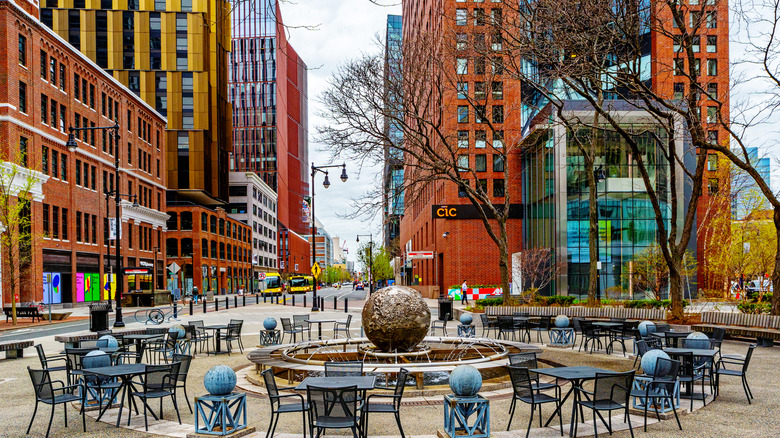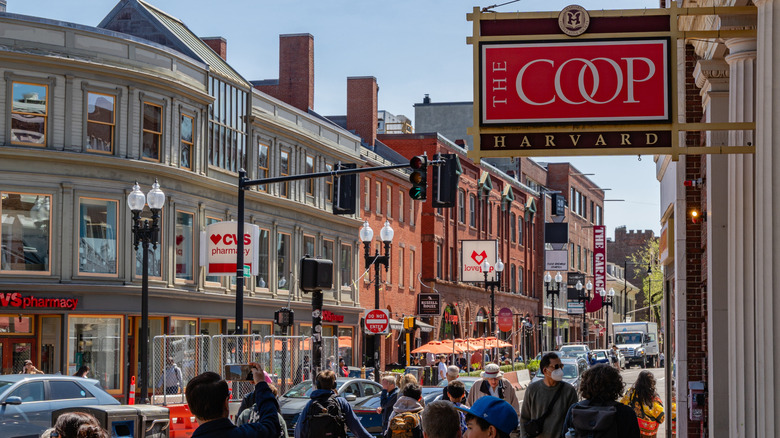New England's Most Famous College Town Is Home To 'The Ugliest Building In America'
New England is famous for its fall foliage, Colonial architecture, and institutions of higher education. Massachusetts, in particular, is a major post-secondary hub. It's home to the Five Colleges of the Pioneer Valley, the colleges of greater Boston, and Cambridge, which is home to Harvard University and the Massachusetts Institute of Technology (MIT). MIT is considered one of the most prestigious schools in the United States, and has been located at its current campus since 1916, amassing an impressive collection of buildings designed by famous architects like I.M. Pei, Eero Saarinen, and Frank Gehry. One that has attracted controversy is Simmons Hall, an undergraduate residence hall that won the 2025 Aesthetic Atrocity Award for "the ugliest building in America." Bestowed by The Architectural Uprising, an international group of architects and urbanists in favor of traditional architecture, the nod is meant to raise awareness of what they deem the blight of Modernism.
Across the Charles River from Boston, Cambridge is a city of 118,000 residents, nearly a quarter of them students. MIT's Simmons Hall is located 15 minutes from Boston-Logan International Airport (BOS) and 13 minutes from Boston's popular Faneuil Hall Marketplace. You can take a tour of MIT's campus and decide on the merits of Simmons Hall yourself and then wander your way through Harvard Square, a historic area full of trendy shops and food. If you're visiting in the fall, consider a 90-minute fall foliage cruise along Boston's Charles River Esplanade, which provides views of MIT's buildings.
About Simmons Hall, America's Ugliest Building
Before we judge Simmons Hall by its concrete cover, let's get to know it first. The 195,000-square-foot student residence opened in 2002 and was designed with function and innovation in mind, featuring 10 floors, three towers, and 5,538 windows. Each room has nine windows with recessed jambs that are red, orange, yellow, blue, or green, creating natural cooling and heating effects. Steven Holl Architects intended the design to be porous and sponge-like, exemplified by the windows and five large openings for natural light. The openings, including entrances and view corridors, are considered the lungs of the building as they let air in to be circulated. Simmons Hall residents have amenities like a dining hall with street-level indoor-outdoor seating, a two-floor gym with views of the Boston skyline, a 200-seat theater, and laundry facilities on almost every floor. The corridors, which are 11 feet wide, were intended to evoke a streetscape atmosphere and invite residents to use them as a lounge.
In a press release by The Architectural Uprising, committee member and architecture critic Michael Diamant calls Simmons Hall, "a top visual offender and a perfect example of design against humanity." When it came to selecting the most unsightly building in the United States, Diamant says, "It was a difficult decision, as unfortunately there were many worthy contenders, but our panel noted, in particular, the building's inhuman scale, awkward structure, and haphazardly placed windows. All of this is evidence of 'architectural malpractice'." The press release goes on to cite a poll that proves Americans strongly prefer classical architecture to Modernism for federal buildings.
Experience Cambridge through its architecture
Cambridge reflects many architectural styles in buildings erected over the centuries. In addition to the MIT architecture discussed above, Harvard has some compelling buildings, as do other locations in the city. At the Harvard Art Museums, the Italian starchitect Renzo Piano brought three museums with different architecture and collections together, most notably with a glass roof over a 1927 brick building. Another Harvard building worth noting is the modern Carpenter Center for the Visual Arts. Le Corbusier's only North American design, it features an asymmetrical façade and deeply recessed rectangular windows.
Cambridge is full of charming neighborhoods, squares that serve as hubs for shopping and dining, green spaces, and museums. While on the MIT campus, stop into the MIT Museum to see exhibitions on robotics, holography, A.I., and marvelous inventions, and explore the hip Kendall Square neighborhood. The Harvard Museum of Natural History is most famous for its beautiful Glass Flowers collection, a garden of delicate flowers crafted from glass. Shop and eat in Harvard Square, perhaps scarfing a double cheeseburger or relaxing in the beer garden at the institution Charlie's Kitchen. The Charles River separates Cambridge from Boston and offers recreational possibilities including sailing, tennis, canoeing, and kayaking. Prefer solid ground? Then you'll love the area's miles of walking, jogging, and biking pathways. To tour by both land and sea, hop on an amphibious vehicle for a Boston Duck Tour that travels through several neighborhoods on land and then splashes into the Charles River for an aquatic exploration.


